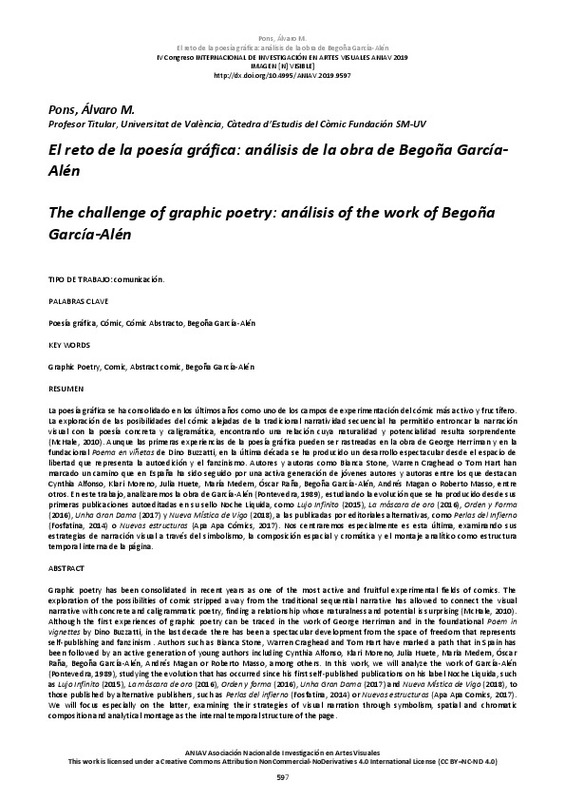JavaScript is disabled for your browser. Some features of this site may not work without it.
Buscar en RiuNet
Listar
Mi cuenta
Estadísticas
Ayuda RiuNet
Admin. UPV
El reto de la poesía gráfica: análisis de la obra de Begoña GarcíaAlén
Mostrar el registro sencillo del ítem
Ficheros en el ítem
| dc.contributor.author | Pons Moreno, Álvaro
|
es_ES |
| dc.date.accessioned | 2019-10-15T06:43:39Z | |
| dc.date.available | 2019-10-15T06:43:39Z | |
| dc.date.issued | 2019-09-10 | |
| dc.identifier.isbn | 9788490487662 | |
| dc.identifier.uri | http://hdl.handle.net/10251/128361 | |
| dc.description.abstract | [ES] La poesía gráfica se ha consolidado en los últimos años como uno de los campos de experimentación del cómic más activo y fructífero. La exploración de las posibilidades del cómic alejadas de la tradicional narratividad secuencial ha permitido entroncar la narración visual con la poesía concreta y caligramática, encontrando una relación cuya naturalidad y potencialidad resulta sorprendente (McHale, 2010). Aunque las primeras experiencias de la poesía gráfica pueden ser rastreadas en la obra de George Herriman y en la fundacional Poema en viñetas de Dino Buzzatti, en la última década se ha producido un desarrollo espectacular desde el espacio de libertad que representa la autoedición y el fanzinismo. Autores y autoras como Bianca Stone, Warren Craghead o Tom Hart han marcado un camino que en España ha sido seguido por una activa generación de jóvenes autores y autoras entre los que destacan Cynthia Alfonso, Klari Moreno, Julia Huete, María Medem, Óscar Raña, Begoña García-Alén, Andrés Magan o Roberto Masso, entre otros. En este trabajo, analizaremos la obra de García-Alén (Pontevedra, 1989), estudiando la evolución que se ha producido desde sus primeras publicaciones autoeditadas en su sello Noche Liquida, como Lujo Infinito (2015), La máscara de oro (2016), Orden y Forma (2016), Unha Gran Dama (2017) y Nueva Mística de Vigo (2018), a las publicadas por editoriales alternativas, como Perlas del Infierno (Fosfatina, 2014) o Nuevas estructuras (Apa Apa Cómics, 2017). Nos centraremos especialmente es esta última, examinando sus estrategias de narración visual a través del simbolismo, la composición espacial y cromática y el montaje analítico como estructura temporal interna de la página. | es_ES |
| dc.description.abstract | [EN] Graphic poetry has been consolidated in recent years as one of the most active and fruitful experimental fields of comics. The exploration of the possibilities of comic stripped away from the traditional sequential narrative has allowed to connect the visual narrative with concrete and caligrammatic poetry, finding a relationship whose naturalness and potential is surprising (McHale, 2010). Although the first experiences of graphic poetry can be traced in the work of George Herriman and in the foundational Poem in vignettes by Dino Buzzatti, in the last decade there has been a spectacular development from the space of freedom that represents self-publishing and fanzinism . Authors such as Bianca Stone, Warren Craghead and Tom Hart have marked a path that in Spain has been followed by an active generation of young authors including Cynthia Alfonso, Klari Moreno, Julia Huete, Maria Medem, Óscar Raña, Begoña García-Alén, Andrés Magan or Roberto Masso, among others. In this work, we will analyze the work of García-Alén (Pontevedra, 1989), studying the evolution that has occurred since his first self-published publications on his label Noche Liquida, such as Lujo Infinito (2015), La máscara de oro (2016), Orden y forma (2016), Unha Gran Dama (2017) and Nueva Mística de Vigo (2018), to those published by alternative publishers, such as Perlas del infierno (Fosfatina, 2014) or Nuevas estructuras (Apa Apa Comics, 2017). We will focus especially on the latter, examining their strategies of visual narration through symbolism, spatial and chromatic composition and analytical montage as the internal temporal structure of the page. | es_ES |
| dc.format.extent | 9 | es_ES |
| dc.language | Español | es_ES |
| dc.publisher | Editorial Universitat Politècnica de València | es_ES |
| dc.relation.ispartof | IV Congreso Internacional de investigación en artes visuales: ANIAV 2019 Imagen [N] visible | es_ES |
| dc.rights | Reconocimiento - No comercial - Sin obra derivada (by-nc-nd) | es_ES |
| dc.subject | Arte | es_ES |
| dc.subject | Producción artística | es_ES |
| dc.subject | Estética | es_ES |
| dc.subject | Teoría del arte | es_ES |
| dc.subject | Gestión cultural | es_ES |
| dc.subject | Educación artística | es_ES |
| dc.subject | Investigación artística | es_ES |
| dc.subject | Poesía gráfica | es_ES |
| dc.subject | Cómic | es_ES |
| dc.subject | Cómic abstracto | es_ES |
| dc.subject | Begoña García-Alén | es_ES |
| dc.title | El reto de la poesía gráfica: análisis de la obra de Begoña GarcíaAlén | es_ES |
| dc.title.alternative | The challenge of graphic poetry: análisis of the work of Begoña García-Alén | es_ES |
| dc.type | Capítulo de libro | es_ES |
| dc.type | Comunicación en congreso | es_ES |
| dc.identifier.doi | 10.4995/ANIAV2019.2019.9597 | |
| dc.rights.accessRights | Abierto | es_ES |
| dc.description.bibliographicCitation | Pons Moreno, Á. (2019). El reto de la poesía gráfica: análisis de la obra de Begoña GarcíaAlén. En IV Congreso Internacional de investigación en artes visuales: ANIAV 2019 Imagen [N] visible. Editorial Universitat Politècnica de València. 597-605. https://doi.org/10.4995/ANIAV2019.2019.9597 | es_ES |
| dc.description.accrualMethod | OCS | es_ES |
| dc.relation.conferencename | IV Congreso Internacional de Investigación en Artes Visuales. ANIAV 2019. Imagen [N] Visible | es_ES |
| dc.relation.conferencedate | Julio 03-05, 2019 | es_ES |
| dc.relation.conferenceplace | Valencia, Spain | es_ES |
| dc.relation.publisherversion | http://ocs.editorial.upv.es/index.php/ANIAV/ANIAV2019/paper/view/9597 | es_ES |
| dc.description.upvformatpinicio | 597 | es_ES |
| dc.description.upvformatpfin | 605 | es_ES |
| dc.type.version | info:eu-repo/semantics/publishedVersion | es_ES |
| dc.relation.pasarela | OCS\9597 | es_ES |








